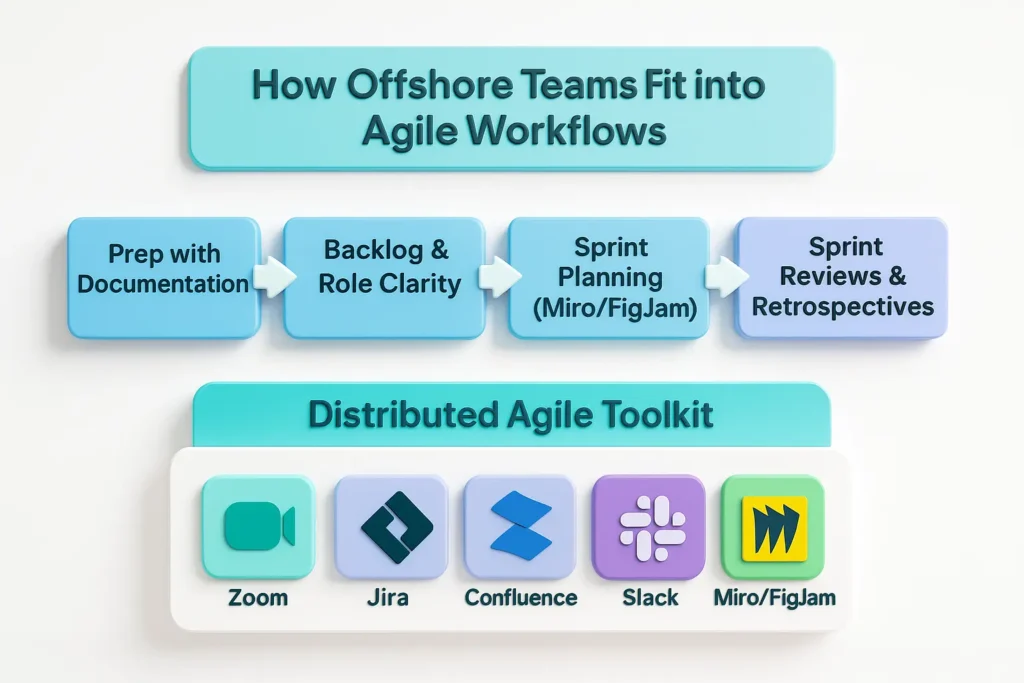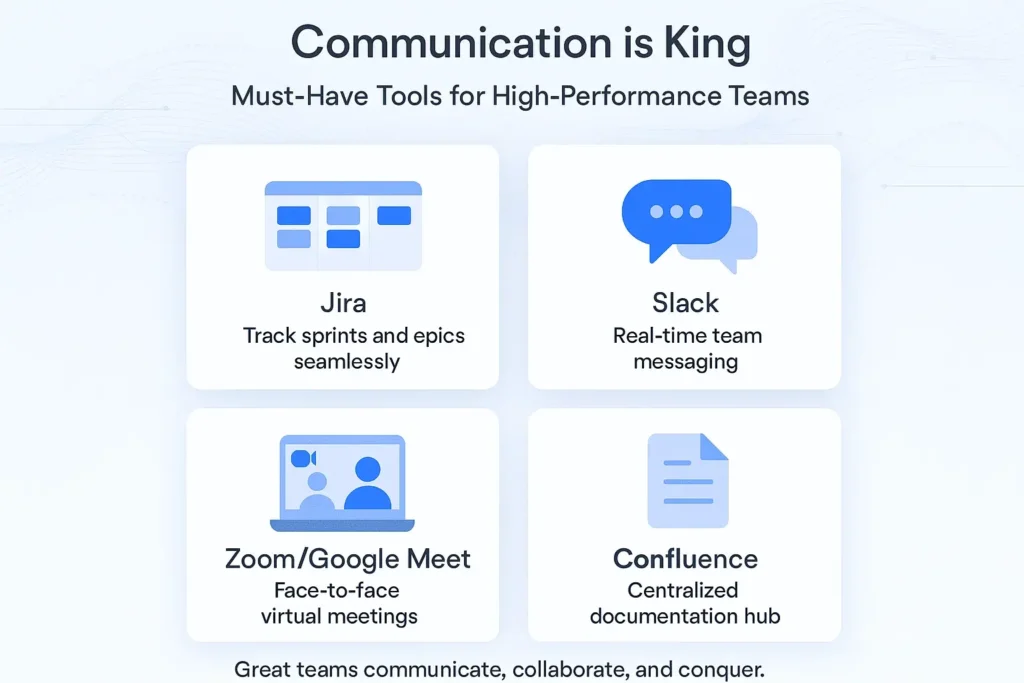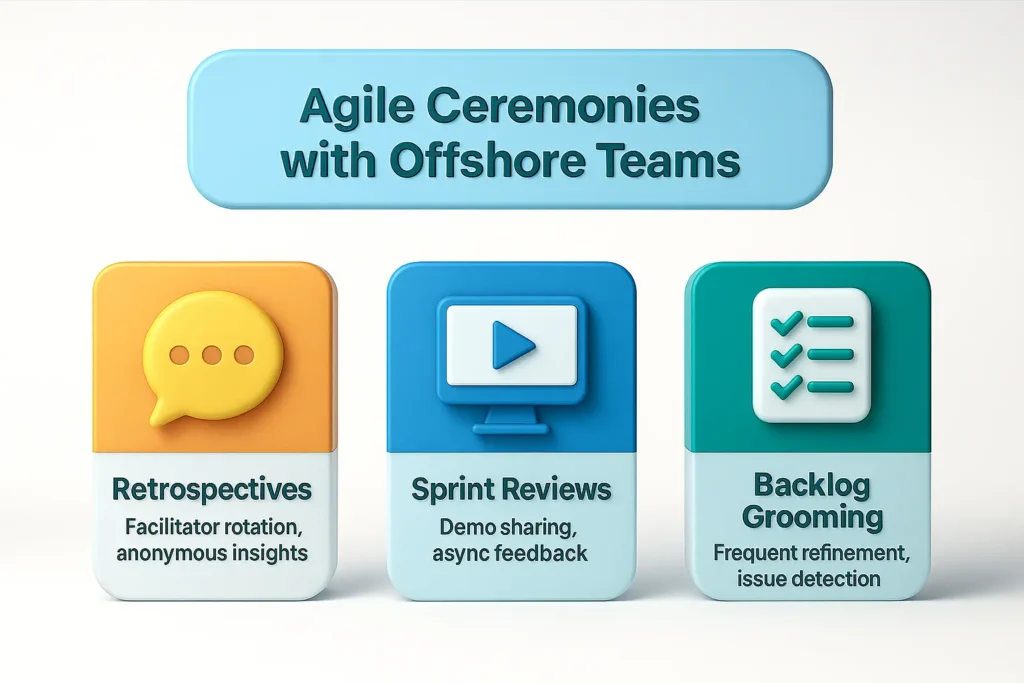The Ultimate Guide for Businesses in the Global Economy
The need for even faster time-to-market, enhanced customer satisfaction, and constant innovation pushes Agile development as one of the most important software engineering practices today. But Agile isn’t just for teams that are in one office anymore. A silent revolution is unfolding in this regard where agile offshore teams take the centre stage to usher in global delivery, innovation, and resilience.
In order to stay competitive in these fast-moving markets, companies are increasingly looking at agile development outsourcing as a strategic factor—not only to cut costs, but to increase agility, access a wider pool of resources and drive productivity around the clock.
Agile was created with small, co-located teams in its sights. Yet as companies grow and become international, so does the necessity of globally distributed teams. The surge in offshore software development has demonstrated that – if managing structure, processes, and attitude effectively – Agile can prove as successful, if not more so, on a global scale.
By spreading agile teams across any given geography, organizations can build, test and deploy software repeatedly. That is to say taking advantage of the offshore development team who are working when the core team is sleeping, resulting in 24/7 productivity and faster time to market. It’s one of the leading causes why the outsourcing of agile development has become increasingly popular, particularly amongst high growth startups and companies going through the digital britches.
Towards an Understanding of Agile Development in a Distributed Environment
At its heart, Agile is about iteratively developing and providing fast feedback and working together. Agile Development To develop easy to use and maintain software, we use agile methodologies. Those are principles that flourish when working through home, not just get along.
There are a few models that support successful Agile implementation with offshore resources:
If one compares it to traditional development processes, the contrast is staggering. Traditional practices are generally more constrained to hard documentation and handing off, but in Agile everyone works together and contributes across the board, providing the best framework for harmonising working with a worldwide community.

Offshore agile teams grow loyalty and boost productivity. With offshoring, companies widen their talent pool, adding world-class experts to their network by creating offshore agile teams at a fraction of local costs.
One of the most apparent reasons to hire an offshore software development team is the reduced cost. The companies could lower operating costs sharply without sacrificing the quality of product. In India, Ukraine, the Philippines, or other outsourced-friendly countries, you can find experienced developers, QA, or DevOps professionals for 3–5 times cheaper than in the Western world, while getting the same quality—paying on average 40–60% less on a team’s salary and infrastructure.
Yet there is more to agile offshore teams than just cost-effectiveness — they introduce diverse experiences, exposure to leading tech, and access to specialized skills, all of which drive innovation.
The local talent pool might be small too, especially when it comes to specialized skills like AI/ML, blockchain, cloud-native app development etc. Onshore recruitment gives you access to technical specialists with strong skills on agile methodologies. Have a hybrid mobile team in mind or take your complex SaaS product global, there’s very little doubt that tapping into international hiring will be invaluable when bridging the skills gap. Building an agile software development team that is geographically diverse allows for continuous progress and innovation.
Another (never talked about) advantage of offshore teams is the time zone advantage. With operations spanning geographies, work doesn’t stop once the onshore team goes offline. The “follow-the-sun” model provides for quicker roll-out and facilitates customer problems or bug fixes to be addressed within hours. This model strengthens agile development with offshore team collaboration.

Distributed Scrum isn’t fancy—however it does take some thought to plan it. Centralized documentation and shared backlogs and well-defined roles are a must for shared understanding and avoiding friction. Sprint ceremonies — planning, reviews, retrospectives — can be done using tools such as Zoom, Jira, Confluence. This is a foundational component of offshore team management.
When overseeing an agile software development outsource, sprint planning needs to account for time zones. That is, it would involve scheduling meetings in overlapping hours, or alternating time slots, to ensure balance. With the help of tools like Miro or FigJam, visualise the sprint goals and keep everyone engaged.
The stand-up meetings can be asynchronous (written updates, Slack threads) or synchronous depending on team maturity and overlap. The important thing is consistency in visibility to all product teams particularly offshore development teams.
Product Owners & Project Managers
Such roles are vital to the bridegroom onshore and offshore teams. The product owner owns the priority and quality of the backlog, and the project manager is responsible for delivery, regional communication. Their role is central to successful offshore roles and responsibilities alignment.
Scrum Masters
The scrum master is the one who helps the team work to capacity, unblock things and move towards the sprint goal. They need to work harder to instill Agile values while keeping team spirit high and strong despite the distances.
Developers and QA Engineers
These are the heart and soul “do-the-work” team members who form the execution engine. In an offshore agile model, the dev and test team must have access to CI/CD tools, automated test and shared platforms in order to be productive in the sprint and aligned with sprint expectations. This infrastructure supports agile software development outsourcing efforts.

Balancing Asynchronous and Synchronous Communication
In absence of time zones which match, asynchronicity is a must. Ensure never losing any information in Loom videos, status updates, or structured documents. Synchronous check-ins remain appropriate to plan, to retrospect, and/or to unblock.
Navigating Cultural and Language Barriers
Diversity comes with new ways of thinking, but it also demands cultural sensitivity. Simple, clear language, training in what cross-cultural communication is and good practice in creating shared meaning can help avoid such confusion and to bind people in solidarity irrespective of borders. This becomes key in offshore hybrid mobile development team scenarios.
Tracking velocity is just as crucial in distributed Agile teams as it is in co-located teams. Gather around burn-down charts to see progress and blockers. Offshore group to have clear accountability of deliverable and acceptance criteria along with the ability to measure sprint goals. This gives teams freedom and keeps them honest.

Engaging Retrospectives
Do not let retrospectives become rote checklists. Employ anonymous feedback mechanisms, rotate facilitators and make visible the action items showing progress.
Productive Sprint Reviews
Share demos between teams, capture them for asynchronous viewing, and extend feedback through forms or collaborative whiteboards.
Global Backlog Grooming
Frequent backlog refinement means that nobody is left behind. The Agile off-shored software development team should be in the loop early on to provide feedback and flag blockers before they blow up. When you outsource agile software, backlog grooming is critical.
A FinTech firm reduced 40% of development spending and had 50% faster release by following an agile offshoring development model. SaaS startup scaled with offshore hybrid mobile development team and sustained weekly sprint velocity. On the other hand, a logistics company who tripped up on clarity over offshore roles and responsibilities showed the need for better onboarding.

Offshore Agility to be Amplified by AI and Automation
AI-enabled test automation to backlog refinement tools -next in agile development with offshore teams- will be tech-augmented and data-driven.
Offshoring vs Nearshoring
Even though the time zone of nearshoring is more convenient, offshoring continues to reign supreme on cost and talent pool diversity. The future may be a mix of both.
Building a Global Agile Culture
Agility is location independent. Forging a world class agile software development team begins with respecting diversity, cultivating inclusivity and prioritising learning.
Agile offshore development isn’t just a workaround — it’s a competitive differentiator. It lets companies innovate, scale and serve globally at speed, and without compromise. So by purposefully and methodically including offshore teams in your Agile processes, you can set your development process up for future success and unlock growth that compounds over time.
No matter if you are new to agile development outsourcing or are looking to optimize your current model, it’s time to become globally agile.
What are the three main roles in an Agile team?
The three main roles in an Agile team are:
What is the role of the lead developer in Agile?
The lead developer directs and guides technical decisions and ensures that the code quality is up to the mark. Along with that, the lead developer also mentors the team and helps in aligning development with Agile goals for delivering high-quality, scalable softwares that is efficient.
What is the main purpose of agile development?
The main purpose of Agile development is to deliver high-quality software very quickly and efficiently. Agile development also promotes flexibility, continuous feedback, and collaboration with stakeholders throughout the development process.
How to improve lead time in agile?
To improve lead time in Agile, you can:
What is scrum master’s salary?
In India, Scrum Masters typically earn ₹8–20 LPA depending on experience, with senior roles in MNCs reaching ₹25+ LPA.
In other countries, average salaries are:
Is Scrum Master a stressful job?
It can be, depending on the environment. Scrum Masters often handle team conflicts, tight deadlines, and stakeholder expectations. However, strong communication skills, supportive leadership, and a mature Agile culture can significantly reduce stress levels.
Are Scrum Masters in demand in 2025?
Yes, Scrum Masters are still in demand in 2025, especially in Agile-focused industries like tech, finance, and healthcare. Certified and experienced professionals remain highly valued, though competition has increased.
What are the 5 events of Scrum?
The 5 Scrum events are:
Join thousands of businesses leveraging offshore staffing to scale their operations globally
Expand effortlessly with My Offshore Employees - access top 1% offshore talent starting at just $3/hr or $600/month per FTE. No hidden fees, no compromises on quality. Your offshore employees work exclusively for you - ensuring focus, transparency, and real-time visibility into your projects. We combine smart automation and proven industry experience to deliver higher productivity, fewer errors, and tailor-made solutions for your business growth.
© 2025. All Rights Reserved.